Compact telehandlers see strong demand
28 June 2022
When it comes to telehandlers, adaptability is the name of the game. And with their small stature, application flexibility, varied power options and an attachment for nearly any need, compact telehandler sales have soared in recent years.
“The massive demand for these compact telehandlers comes from the versatility that they offer and its very small footprint which allows it to be utilized in areas where larger telehandlers cannot operate,” says Austin Bailey, sales manager of AMS Merlo. “Being a small telehandler also means it is the most budget-friendly and more companies can afford them.”
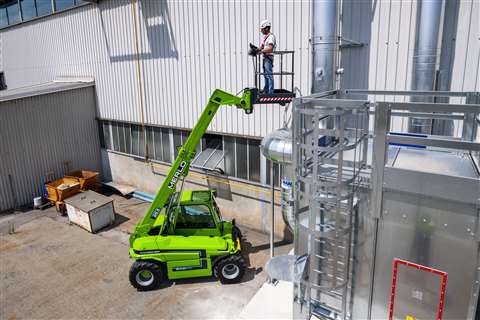 Later this year, Merlo will debut a brand-new compact unit, the e-Worker 25.5-90, pictured here. (Photo: Merlo.)
Later this year, Merlo will debut a brand-new compact unit, the e-Worker 25.5-90, pictured here. (Photo: Merlo.)
In response to growing requests for these units, later this year Merlo will debut a brand-new compact unit, the e-Worker 25.5-90. Weighing 10,913 pounds, the unit will have a 5,500 -pound operating capacity, 16-foot lift height and 8-foot, 5-inch reach.
“It’s quite compact with a width of 5 feet, length of 10 feet, 9 inches and height of 6 feet, 5 inches,” Bailey notes. “As with all Merlos, it has a low pivot, no-flex boom. It accepts many attachments also. The models coming into the U.S. will have enclosed cabs with 360-degree operator view, ergonomic seating, and other operator centric options.”
Also coming to market soon will be three new compact models from Manitou Group. Set to debut in June, the Gehl GCT 3-14, Manitou ULM 412 and ULM 415 are “super compact telehandlers,” says Steve Kiskunas, product manager – telescopic handlers, Manitou Group.
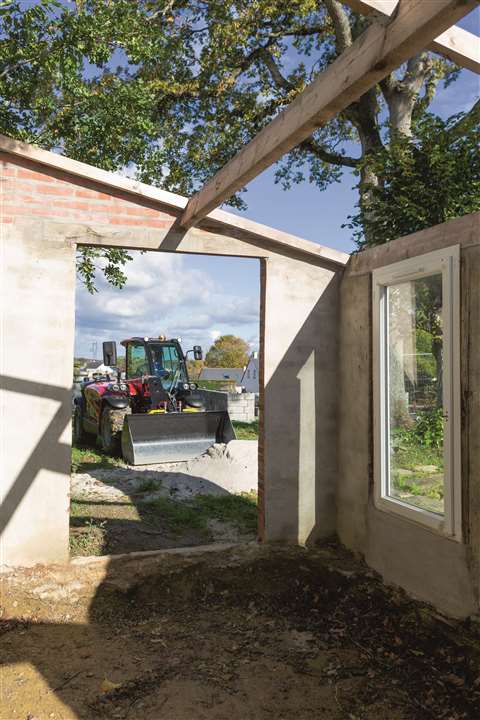 Manitou will launch the ULM 412 and ULM 415 “super compact telehandlers” this year. (Photo: Manitou Group.)
Manitou will launch the ULM 412 and ULM 415 “super compact telehandlers” this year. (Photo: Manitou Group.)
“Customer demand for a powerful compact material handler is behind the increasing demand for these new models,” Kiskunas says. “While the traditional telehandler is a proven jobsite must, the opportunity for these compact units to provide that same powered material placement is exciting for contractors who have sites or projects which are to compact for the traditional machines.”
Manitou expects the compact market to grow rapidly “as demand continues to be greater than supply,” Kiskunas notes. “We expect that growth to continue with increasing demand as these products are still at a very early stage of adoption by customers.”
Thinking ahead, Kiskunas expects new power systems to be unveiled by OEMs but believes the technology will “not driven by government regulation in North America, but by customer needs for rough terrain material handling with electrical power.
Manitou is expected to debut alternative-powered telehandlers in less than 12 months.
Additional drivers
Increasing operator confidence and productivity on jobsites continues to push change across the telehandler market for JLG.
 JLG’s SkyTrak 3013 is one of the industry’s most-compact telehandlers. (Photo: JLG.)
JLG’s SkyTrak 3013 is one of the industry’s most-compact telehandlers. (Photo: JLG.)
“That’s because there are always jobs to be done, and telehandler OEMs, including JLG, continue to look at ways that these machines can help operators do more and different types of work, as well as help operators be more effective and efficient in the work they do,” says JLG’s John Boehme, senior product manager – telehandlers. “You can see examples of this in the latest telehandler features introduced in recent years.”
For instance, Boehme notes, select JLG telehandlers are now equipped with a Load Stability Indication (LSI) system which can aid operators by helping them to remain within the forward load capacity of the telehandler. Also, advancements in backup camera technology, such as JLG’s multi-reverse camera system, can help operators see more on the backside of the machine. Lastly, advancements in boom control technology, such as JLG’s remote boom control, enable operators to control the telehandler’s boom from outside the cab.
JLG’s most-recent compact debut was its SkyTrak 3013, which was designed to meet the needs of landscapers, hardscapers, light construction and small industrial work, as well as select agricultural applications. The machine weighs approximately 5,300 pounds with a load capacity of 2,700 pounds and offers a 13-foot lift height.
JLG sees demand for compact telehandlers continuing due in part to increasing construction activity.
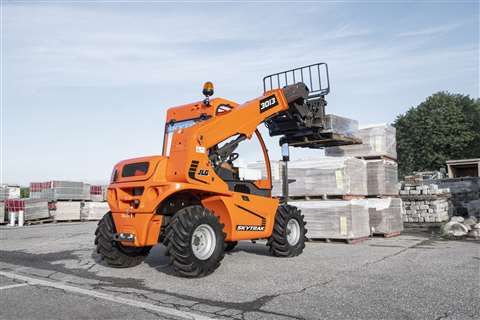 JLG’s SkyTrak 3013 weighs a total of 5,300 pounds. (Photo: JLG.)
JLG’s SkyTrak 3013 weighs a total of 5,300 pounds. (Photo: JLG.)
“[Compact telehandlers] are right-sized for completing so many different tasks on jobsites, and this flexibility means that compact telehandlers can get a large variety of work done on a project, from the initial phases to the closing stages,” Boehme says. “Contractors can use one compact telehandler to get a wide variety of tasks done, rather than having to use multiple machines to do the same work.”
Three key demand factors
“The demand of compact telehandlers has increased every year for the past decade, so I don’t believe that will change,” says Robby Hagan, VP of North American sales for Xtreme Manufacturing and Snorkel. “More and more jobsites are operating within confined spaces and on minimized budgets, plus, socially aware companies are utilizing environmentally friendly equipment more frequently.
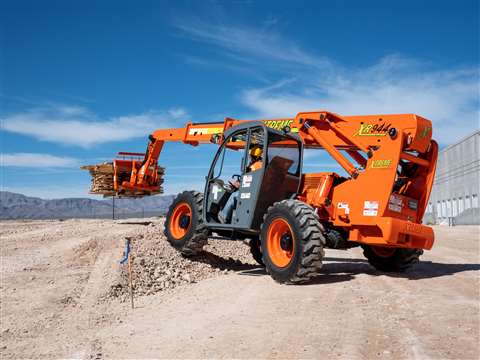 According to Xtreme, the demand of compact telehandlers has increased every year for the past decade. (Photo: Xtreme Manufacturing.)
According to Xtreme, the demand of compact telehandlers has increased every year for the past decade. (Photo: Xtreme Manufacturing.)
“Regarding confined spaces, for example, many high-rise jobsites utilize the parking garage to store materials that will be used to complete the project,” Hagan says. “This brings in height, width, length and weight restrictions that compact machines are designed to comply with.
“On the subject of restricted budgets, materials and other skyrocketing costs are causing companies to revisit the construction processes. One way to minimize expense is to buy or rent a compact machine for tasks that are traditionally done by larger telehandlers.”
And when it comes to environmental concerns, Hagan explains, compact machines equipped with 74hp-or-less engines reduce the amount of pollutants discharged into the environment – and some compact machines have lithium-ion battery technology, which boast zero emissions.
Eco-friendly telehandlers
For JCB, the compact telehandler market continues to be one of the strongest market segments in the industry with an increasing number of models offered.
“The demand for compact telehandlers continues to grow as the construction industry grows especially with national focus on building infrastructure,” says Rebecca Yates, JCB’s senior product manager – material handling. “However, compact telehandlers are not only used in the construction industry. Other markets such as logistics, landscaping, agriculture and municipalities find that a compact telehandler can have a positive impact on productivity and the cost of doing business.”
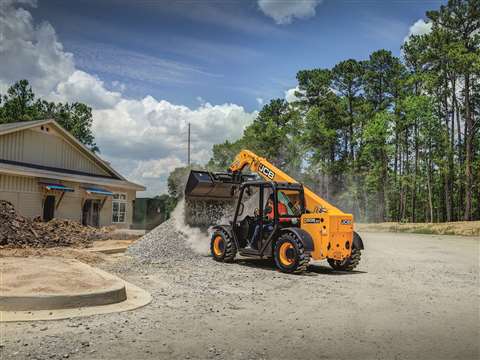 > For JCB, the compact telehandler market continues to be one of the strongest market segments in the industry with an increasing number of models offered. (Photo: JCB.)
> For JCB, the compact telehandler market continues to be one of the strongest market segments in the industry with an increasing number of models offered. (Photo: JCB.)
In 2021, JCB introduced the 505-20E electric compact telehandler with a maximum capacity of 5,250 pounds, slightly lower than its diesel sibling due to a lower operating weight, but maintaining an industry-leading 20 feet of lift height. The 505-20E is powered by a 96V Lithium-ion battery and includes a 110V standard on-board charger as well as rapid charger port.
The addition of electric power options on telehandlers can also provide new application opportunities like working around food and animals, underground or in noise-sensitive areas or times.
Speaking to market requests, Yates believes the momentum will continue. “It is not likely that the market growth will slow down in the next year as the opportunities and applications for compact telehandlers continue to expand,” she says.
No need to go larger
“When it comes to telehandlers, we often talk about the trend toward going bigger and higher,” notes Amalija Kopac, Genie product manager. “But in reality, there is also strong demand for smaller telehandlers, because they are incredible versatile machines. Compact telehandlers can be outfitted with various tire options and attachments, providing load handling flexibility on constrained worksites for both indoor and outdoor applications.”
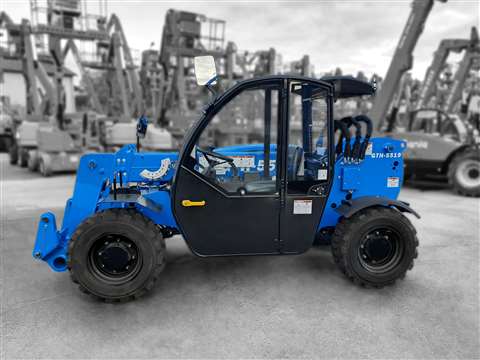 Genie’s GTH-5519. (Photo: Genie)
Genie’s GTH-5519. (Photo: Genie)
Genie’s GTH-5519 telehandler is the company’s “smallest” unit. Featuring a 7-foot, 6-inch wheelbase and center ground clearance of more than 1 foot, 2 inches, the unit offers users three steering modes to boost its flexibility. A Deutz TD 2.9 L4 Tier 4 final engine provides the necessary power to operate full time 4WD, variable speed hydrostatic drive and auxiliary hydraulic circuit, while also meeting today’s emission standards.
“Compact telehandlers are a fast-growing class, and we’ve continued to see strong and steady demand,” Kopac says. “Genie’s compact telehandler, the GTH-5519, is a proven, durable and versatile machine that meets the range of a variety of applications, from construction and masonry to landscape and agriculture.”
Speaking to the market, however, Kopac cautions: “As a result of strong demand and global supply chain disruptions, most, if not all, manufacturers are experiencing backlogs. Even as demand is expected to remain robust for at least the next 12 months, it is dependent on market conditions and situations.”





